- 钛学术文献服务平台 \
- 学术期刊 \
- 医药卫生期刊 \
- 外科学期刊 \
- 亚洲男性学杂志(英文版)期刊 \
基本信息来源于合作网站,原文需代理用户跳转至来源网站获取
摘要:
Fusion between the transmembrane protease serine 2 and v-ets erythroblastosis virus E26 oncogene homolog (TMPRSS2-ERG fusion) is a common genetic alteration in prostate cancer among Western populations and has been suggested as playing a role in tumorigenesis and progression of prostate cancer.However,the prevalence of TMPRSS2-ERG fusion differs among different ethnic groups,and contradictory results have been reported in Asian patients.We aim to evaluate the prevalence and significance of TMPRSS2-ERGfusion as a molecular subtyping and prognosis indicator of prostate cancer in Asians.We identified the fusion status in 669 samples from prostate biopsy and radical prostatectomy by fluorescence in situ hybridization and/or immunohistochemistry in China.We examined the association of TMPRSS2-ERG fusion with clinicopathological characteristics and biochemical recurrence by Chi-square test and Kaplan-Meier analysis.Finally,a systematic review was performed to investigate the positive rate of the fusion in Asian prostate cancer patients.McNemar's test was employed to compare the positive rates of TMPRSS2-ERG fusion detected using different methods.The positive rates of TMPRSS2-ERG fusion were 16% in our samples and 27% in Asian patients.In our samples,9.4% and 19.3% of cases were recognized as fusion positive by fluorescence in situ hybridization and immunohistochemistry,respectively.No significant association between the fusion and clinical parameters was observed.TMPRSS2-ERG fusion is not a frequent genomic alteration among Asian prostate cancer patients and has limited significance in clinical practices in China.Besides ethnic difference,detection methods potentially influence the results showing a positive rate of TMPRSS2-ERG fusion.

推荐文章
期刊_丙丁烷TDLAS测量系统的吸收峰自动检测
带间级联激光器
调谐半导体激光吸收光谱
雾剂检漏 中红外吸收峰 洛伦兹光谱线型
不同盐度、温度及光照对漂浮浒苔生理生态的影响
浒苔
盐度
温度
光照
生理生态
期刊_联合空间信息的改进低秩稀疏矩阵分解的高光谱异常目标检测
高光谱图像
异常目标检测 低秩稀疏矩阵分解 稀疏矩阵 残差矩阵
内容分析
关键词云
关键词热度
相关文献总数
(/次)
(/年)
文献信息
| 篇名 | |||
| 来源期刊 | 亚洲男性学杂志(英文版) | 学科 | |
| 关键词 | |||
| 年,卷(期) | 2020,(2) | 所属期刊栏目 | |
| 研究方向 | 页码范围 | 200-207 | |
| 页数 | 8页 | 分类号 | |
| 字数 | 语种 | 英文 | |
| DOI | 10.4103/aja.aja_45_19 | ||
五维指标
引文网络
引文网络
二级参考文献 (158)
共引文献 (55)
参考文献 (70)
节点文献
引证文献 (0)
同被引文献 (0)
二级引证文献 (0)
1900(2)
- 参考文献(1)
- 二级参考文献(1)
1991(1)
- 参考文献(0)
- 二级参考文献(1)
1994(2)
- 参考文献(0)
- 二级参考文献(2)
1995(1)
- 参考文献(0)
- 二级参考文献(1)
1997(1)
- 参考文献(0)
- 二级参考文献(1)
1998(4)
- 参考文献(0)
- 二级参考文献(4)
2002(2)
- 参考文献(0)
- 二级参考文献(2)
2003(3)
- 参考文献(1)
- 二级参考文献(2)
2004(3)
- 参考文献(0)
- 二级参考文献(3)
2005(6)
- 参考文献(2)
- 二级参考文献(4)
2006(15)
- 参考文献(1)
- 二级参考文献(14)
2007(27)
- 参考文献(4)
- 二级参考文献(23)
2008(27)
- 参考文献(6)
- 二级参考文献(21)
2009(37)
- 参考文献(5)
- 二级参考文献(32)
2010(39)
- 参考文献(6)
- 二级参考文献(33)
2011(14)
- 参考文献(4)
- 二级参考文献(10)
2012(9)
- 参考文献(8)
- 二级参考文献(1)
2013(4)
- 参考文献(1)
- 二级参考文献(3)
2014(9)
- 参考文献(9)
- 二级参考文献(0)
2015(9)
- 参考文献(9)
- 二级参考文献(0)
2016(7)
- 参考文献(7)
- 二级参考文献(0)
2017(4)
- 参考文献(4)
- 二级参考文献(0)
2018(2)
- 参考文献(2)
- 二级参考文献(0)
2020(0)
- 参考文献(0)
- 二级参考文献(0)
- 引证文献(0)
- 二级引证文献(0)
引文网络交叉学科
相关学者/机构
期刊影响力
亚洲男性学杂志(英文版)
主办单位:
中国科学院上海药物研究所
出版周期:
双月刊
ISSN:
1008-682X
CN:
31-1795/R
开本:
大16开
出版地:
上海市太原路294号16号楼302室
邮发代号:
4-648
创刊时间:
1999
语种:
eng
出版文献量(篇)
2771
总下载数(次)
1
总被引数(次)
9935
期刊文献
相关文献
推荐文献
- 期刊分类
- 期刊(年)
- 期刊(期)
- 期刊推荐
亚洲男性学杂志(英文版)2022
亚洲男性学杂志(英文版)2021
亚洲男性学杂志(英文版)2020
亚洲男性学杂志(英文版)2019
亚洲男性学杂志(英文版)2018
亚洲男性学杂志(英文版)2017
亚洲男性学杂志(英文版)2016
亚洲男性学杂志(英文版)2015
亚洲男性学杂志(英文版)2014
亚洲男性学杂志(英文版)2013
亚洲男性学杂志(英文版)2012
亚洲男性学杂志(英文版)2011
亚洲男性学杂志(英文版)2010
亚洲男性学杂志(英文版)2009
亚洲男性学杂志(英文版)2008
亚洲男性学杂志(英文版)2007
亚洲男性学杂志(英文版)2006
亚洲男性学杂志(英文版)2005
亚洲男性学杂志(英文版)2004
亚洲男性学杂志(英文版)2003
亚洲男性学杂志(英文版)2002
亚洲男性学杂志(英文版)2001
亚洲男性学杂志(英文版)2020年第6期
亚洲男性学杂志(英文版)2020年第5期
亚洲男性学杂志(英文版)2020年第4期
亚洲男性学杂志(英文版)2020年第3期
亚洲男性学杂志(英文版)2020年第2期
亚洲男性学杂志(英文版)2020年第1期

 免费查重
免费查重










